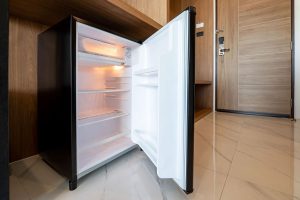Updated on March 13, 2023
In this article, we’re referring to the rectangular or cube-shaped versions that commonly have these dimensions (roughly): However, it might be much smaller or even higher, depending on how much space you have.
Electronics stores often charge more than $100 for one of these, and they generally look like a basic refrigerator both inside and out, with many sections and compartments for storing food.
Does a tiny fridge meet or exceed the minimum cabinet temperature of a regular refrigerator? Depending on the brand (quality), yes, they can easily keep temperatures below 40F at all parts of the cabinet. If you have a high-quality small fridge, you won’t have to worry about the freezer not being able to maintain temperatures below freezing for long.
By this categorization, your little wine coolers, portable coolers, beverage coolers and all those little fridges that easily fall into this bracket aren’t part of the discussion.
And by the way, why would anyone ever consider storing a perishable item like meat for an extended period of time inside such warm confinement by the refrigeration standards?
Has the regular refrigerator not taught you enough lesson during the unavoidable periods of black out or malfunctioning?

Mini fridges, on the other hand, have long been one of the most convenient ways for my family to enjoy beverages, snacks, and leftovers from the night before.
Especially as a busy college student, I’m sure it’s been a challenge for you as well.
Is a mini-fridge nothing more than a small refrigerator for storing drinks and sodas?
What about meat and other perishables, such as seafood and veggies and fruits?
They can, of course! Once again, we’ve overestimated the capabilities of a little equipment (smirking at the microwave and toaster oven).
Regardless of the condition in which they arrive, meat and other perishables may be stored in a little refrigerator for a limited length of time.
Because most small fridges have uneven cabinet temperatures, these products are best kept in the refrigerator (which reduces storage time even more) than in the freezer.
In the next paragraphs, you’ll find out why. In addition, you’ll discover the best practises for preserving meat in a tiny fridge.
So how do I know I have a high quality mini fridge?
A reliable seller, a trustworthy brand, and a fridge that can consistently maintain a temp above freezing (a maximum of 40F) in the refrigerator compartment and below 32F in the freezer compartment, even when room temperature items are stuffed inside the fridge, are all things that typically cost a lot of money to acquire.
A refrigerator thermometer should be used instead of relying only on the temperature indicated on the fridge’s electronic screen ( if it has has one).
Checking the temperature of a refrigerator’s cabinet may be done with the use of a refrigerator thermometer.
- Put a thermometer in a cup half-full of water and see whether the temperature rises. As opposed to merely putting the thermometer inside the fridge, this method allows you to get a better idea of the temperature of the food itself, rather than just measuring the temperature of the air surrounding it.
- For an accurate reading, take the cup from the refrigerator and leave it there for at least 24 hours before removing it again. If required, use the reading to adjust the refrigerator’s temperature, and then repeat the process.
- The freezer compartment should be treated in the same manner as well. Also, the coldest portion of the fridge and freezer can be of interest to you. For the test, just repeat the technique in various areas of the freezer and fridge. It’s important to know where to store perishables in your tiny fridge, and this guide will help you do that.
- Don’t use the tiny fridge to store perishables like meat if you can’t consistently maintain a temperature below 40 F in the refrigerator and below 32 F in the freezer.
Store perishables in the refrigerator only when the interior temperature swings by a tiny amount and returns rapidly to the appropriate range, such as when you fill the fridge with room temperature products like bottled water.
There are times when preserving beef in a freezer might be beneficial.
How are mini fridges different from standard refrigerators?
To put it simply, we can say that the fundamental difference between the two is that a conventional house refrigerator is much larger than a compact fridge.
The term comes from the fact that the former is normally larger than the latter, which is typically smaller.
Cooling performance is roughly same between a high-quality micro fridge and a normal household refrigerator.
In other words, they can constantly keep the cabinet at or below 40 degrees Fahrenheit.
A high-quality mini-freezing fridge’s chamber may also contain goods that are below the water’s freezing point (32F).
Even if you put a high-quality small fridge up against a regular one, you won’t be able to discern the difference when it comes to cooling, chilling, or freezing outcomes.
But a mid-priced or low-priced compact refrigerator? To put germs into a brief coma, you’ll need a temperature of 40 F or below, and they aren’t capable of maintaining that level of temperature consistently.

